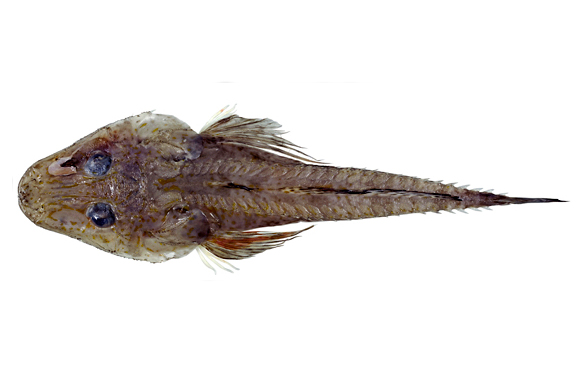Deepsea Flathead, Hoplichthys haswelli McCulloch 1907

Deepsea Flathead, Hoplichthys haswelli. Source: Australian National Fish Collection, CSIRO. License: CC by Attribution-NonCommercial
Deepsea Flathead, Hoplichthys haswelli McCulloch 1907
More Info
|
Distribution |
Benthic on soft-bottom habitats of the outer continental shelf and continental slope (~150-1500 m) of the south-western Pacific (southern Australia and New Zealand). Australian range is from southern Queensland (off Danger Point, ~28o06'S) to the Great Australian Bight (Eucla, ~126o30'E), Western Australia. including Tasmania. Records from southwestern and central Western Australia northwards to Shark Bay region (~26oS) require confirmation. This species is widespread and common in New Zealand waters. |
|
Features |
Meristic features: Dorsal-fin spines/rays V (rarely VI), 13-14; Anal-fin spines/rays I, 15-17; Caudal-fin rays 11; Pectoral-fin rays 13-14 + 4-5; Pelvic-fin spines/rays: I, 4-5; Vertebrae 26; Gill rakers 15-18 (incl rudiments); Lateral line 26-28 scutes. Body depressed, shallow (16-26% SL), elongate, moderately narrow, tapering to very narrow caudal peduncle. Head large (36-42% SL), very broad and depressed, covered with numerous spines; eyes of moderate size (14-25% HL); interorbital slightly concave, its width variable depending on growth stage (27-65% eye length), suborbital region smooth; mouth large (upper jaw length 34-39% HL), horizontal, lower jaw extending forward slightly in advance of upper; teeth fine, needle-like, broad band in each jaw, strip on palatines and crescentic band with pair of posterior extensions on vomer; serrated, spine-bearing bony ridge along lateral edge of head ending in prominent preopercular spine on each side, additional spines based on bony plates behind eye, across top of head and on opercles. Scales mostly absent, few widely scattered, rather embedded cycloid scales posteriorly on upper portion of sides; lateral line mostly straight, associated with series of prominent bony plates each bearing blade-like spine. Two dorsal fins, first small, widely separated from second, second with long base, highest anteriorly; anal fin similar to and opposite second dorsal but extending slightly farther posteriorly; caudal fin squared off or emarginate, upper and lower rays sometimes slightly longer than others. Pectoral fins large, lower four rays unconnected by membranes, and thicker than others. Ventral fins widely separated, inserted well in advance of pectorals, reaching half way to anus. |
|
Size |
Maximum length at least 43cm (type). Stewart (2003) reported to at least 45 cm SL, but usually caught at 25-30 cm SL in New Zealand. |
|
Colour |
Pinkish yellow to yellowish brown or tan above, pinkish on sides with darker mottling, ventral surface white; series of dusky blotches midlaterally in small specimens; dorsal, caudal and pectoral fins pinkish to yellowish brown, remaining fins white, all but ventrals darker distally, second dorsal with vertical dark streaks on membranes in small specimens, oblique dark bands in larger individuals, dark band on anal fins of males. Caudal fin with black margin, eyes bright blue when freshly collected. |
|
Feeding |
Food items of Hoplichthys species include fishes and decapod crustaceans. |
|
Fisheries |
Usually taken in trawls, although not commercially harvested. Reputedly a good table fish, but low meat yield limits commercial use. |
|
Conservation |
|
|
Species Citation |
Hoplichthys haswelli, McCulloch 1907, Rec. Aust. Mus. 6(5): 351, Pl. 64, 35 miles east of Port Jackson, N. S. W., Australia, depth 800 fathoms. |
|
Author |
CSIRO Marine & Atmospheric Research |
Deepsea Flathead, Hoplichthys haswelli McCulloch 1907
References
Gomon, M.F., Glover, J.C.M. & Kuiter, R.H. (1994) The Fishes of Australia's South Coast. State Print, Adelaide, 992 pp.
Hutchins, J.B. (2001) Checklist of the fishes of Western Australia. Rec. West. Aust. Mus. Suppl. 63: 9-50.
Last, P.R., Scott, E.O.G. & Talbot, F.H. (1983). Fishes of Tasmania, Tasmanian Fisheries Development Authority, Hobart, 563 pp.
May, J.L. & Maxwell, J.G.H. (1986) Field guide to the trawl fish from temperate waters of Australia. CSIRO Division of Fisheries Research, Hobart. 492pp.
McCulloch, A.R. (1907) The results of deep sea investigation in the Tasman Sea. II. The expedition of the "Woy Woy." 1. Fishes and crustaceans from eight hundred fathoms. Rec. Aust. Mus. 6(5): 345-355, Pls. 63-65.
McCulloch, A.R. (1914) Report on some fishes obtained by the F. I. S. "Endeavour" on the coasts of Queensland, New South Wales, Victoria, Tasmania, South and South-western Australia. Part II. Biol. Results "Endeavour" v. 2 (pt 3): 77-165, Pls. 13-34.
McGrouther, M.A. (1999). Family Hoplichthyidae. Pp. 2422-2424 In Carpenter, K.E. & Niem, V.H. (eds). The Living Marine Resources of the Western Central Pacific. FAO Species Identification Guide for Fisheries Purposes. Rome. FAO Vol. 4 pp. 2069-2790.
Paxton, J.R., Gates, J.E. McGrouther, M.A. & Hoese, D.F. (2006). Hoplichthyidae (pp. 949-950). In: Zoological Catalogue of Australia. Volume 35. Fishes.
Paulin, C.D., Stewart, A., Roberts, C.D. & McMillan, P.J. (1989) New Zealand fish a complete guide. National Museum of New Zealand Miscellaneous Series.
Stewart, A. & Roberts, C. (2003). Ghost Flatheads. Seafood New Zealand. Mar 2003: 61
Thompson, E.F. (1930). New records of the genera Centrophorus and Hoplichthys in New Zealand. Rec. Canterbury Mus. 3: 275-279, Pls. 1-3.
Yabe (1990) in Amaoka, K., K. Matsuura, T. Inada, M. Takeda, H. Hatanaka & K. Okada (eds.) 1990. Fishes collected by the R/V Shinkai Maru around New Zealand. Japan Marine Fishery Resource Research Center. Fish New Zealand: 1-410, Color figs. p240.



